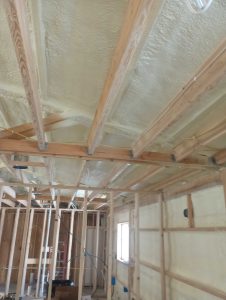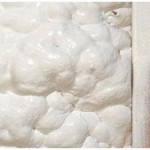Unvented Post Frame Attics
 Energy efficiency concerns have literally become a “hot” (pun intended) topic in new construction, and post frame construction methods are no exception to inclusion. Traditionally buildings have had insulation placed or blown into dead attic spaces, directly above a ceiling. Unvented attics have entered fray as an alternative.
Energy efficiency concerns have literally become a “hot” (pun intended) topic in new construction, and post frame construction methods are no exception to inclusion. Traditionally buildings have had insulation placed or blown into dead attic spaces, directly above a ceiling. Unvented attics have entered fray as an alternative.
To construct an unvented attic, air-impermeable insulation (think closed cell spray foam) will be applied in direct contact with steel roofing (or sheathing) underside and gable end walls so as to tie roof insulation into wall insulation below. Moving insulation boundary to the roof deck underside allows temperature and humidity conditions in the attic to be reasonably close to those of the conditioned building interior. No attic floor vapor retarder or insulation should be installed with an unvented attic assembly.
Closed cell spray foam insulation products meet code requirements for use of an air-impermeable barrier applied to underside of roof. This prevents air infiltration and limits accumulation of airborne moisture in the attic. Using closed cell spray foam insulation applied to underside of roof deck eliminates a need for alternative methods of condensation control such as reflective radiant barriers or CondenStop (https://www.hansenpolebuildings.com/2014/07/condenstop/).
In hurricane or wildfire prone areas wind-driven rain or embers cannot enter an unvented attic assembly, as there are no vents.

Spray Foam
Vented attic designs originated in cold climate areas. In these cold climates, attic ventilation is commonly used to remove warm, humid air from attic spaces. Air leakage from conditioned spaces below a ceiling greatly increased likelihood of moist air entering attics. Without adequate attic ventilation, the underside of the roof deck can have condensation form and interior heat can cause roof surface snowmelt leading to ice damming.
Use of venting to control moisture in cold climate attics comes with some inherent challenges. In high snowfall areas, snow accumulation and drifting can often block ridge vents. This limits venting and increases potential of damage due to ice damming, roof leaks and condensation.
Closed cell spray foam does not come without added upfront investment costs, however some of these can be mitigated in materials and/or labor savings.
Considering climate control of your new post frame building? If so, an unvented attic may be a viable solution worth investigating.






